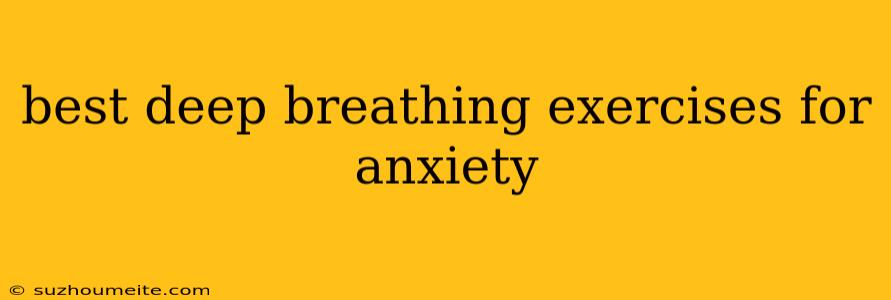Best Deep Breathing Exercises for Anxiety
Anxiety is a common mental health condition that can manifest in many ways, including physical symptoms like shortness of breath, rapid heartbeat, and muscle tension. Deep breathing exercises are a powerful tool for managing anxiety, as they can help to calm the nervous system, slow down your heart rate, and relax your muscles.
Here are some of the best deep breathing exercises for anxiety:
1. Diaphragmatic Breathing
This technique focuses on using your diaphragm, the large muscle under your lungs, to breathe deeply.
Steps:
- Find a comfortable position: Sit or lie down with your back straight and your shoulders relaxed.
- Place one hand on your chest and the other on your abdomen.
- Inhale slowly through your nose, allowing your abdomen to expand. Your chest should remain relatively still.
- Exhale slowly through your mouth, allowing your abdomen to contract.
- Repeat steps 3-4 for 5-10 minutes.
2. Box Breathing
This technique is simple and easy to remember.
Steps:
- Inhale slowly through your nose for a count of 4.
- Hold your breath for a count of 4.
- Exhale slowly through your mouth for a count of 4.
- Hold your breath for a count of 4.
- Repeat steps 1-4 for 4-5 rounds.
3. Alternate Nostril Breathing
This technique is believed to balance the left and right hemispheres of the brain, promoting relaxation.
Steps:
- Sit comfortably with your spine straight.
- Close your right nostril with your right thumb.
- Inhale slowly through your left nostril.
- Close your left nostril with your ring finger and pinky.
- Exhale slowly through your right nostril.
- Inhale slowly through your right nostril.
- Close your right nostril and exhale slowly through your left nostril.
- Repeat steps 3-7 for 5-10 minutes.
4. 4-7-8 Breathing
This technique is often called the "relaxing breath" and is known for its ability to induce sleep.
Steps:
- Close your eyes and exhale completely.
- Inhale slowly through your nose for a count of 4.
- Hold your breath for a count of 7.
- Exhale slowly through your mouth for a count of 8.
- Repeat steps 1-4 for 3-4 rounds.
Tips for Effective Breathing Exercises:
- Practice regularly: The more you practice, the better you'll become at using deep breathing to manage anxiety.
- Find a quiet space: Avoid distractions and focus on your breath.
- Pay attention to your body: Notice the sensations of your breath as you inhale and exhale.
- Don't judge yourself: It's normal to experience some difficulty at first. Be patient and keep practicing.
- Combine with other relaxation techniques: Deep breathing can be combined with other techniques like meditation, mindfulness, or yoga to enhance its effects.
Remember, deep breathing is not a cure for anxiety, but it can be a helpful tool for managing symptoms and reducing stress. If you are struggling with anxiety, it's important to seek professional help from a mental health professional. They can provide you with a personalized treatment plan that may include therapy, medication, or other interventions.
